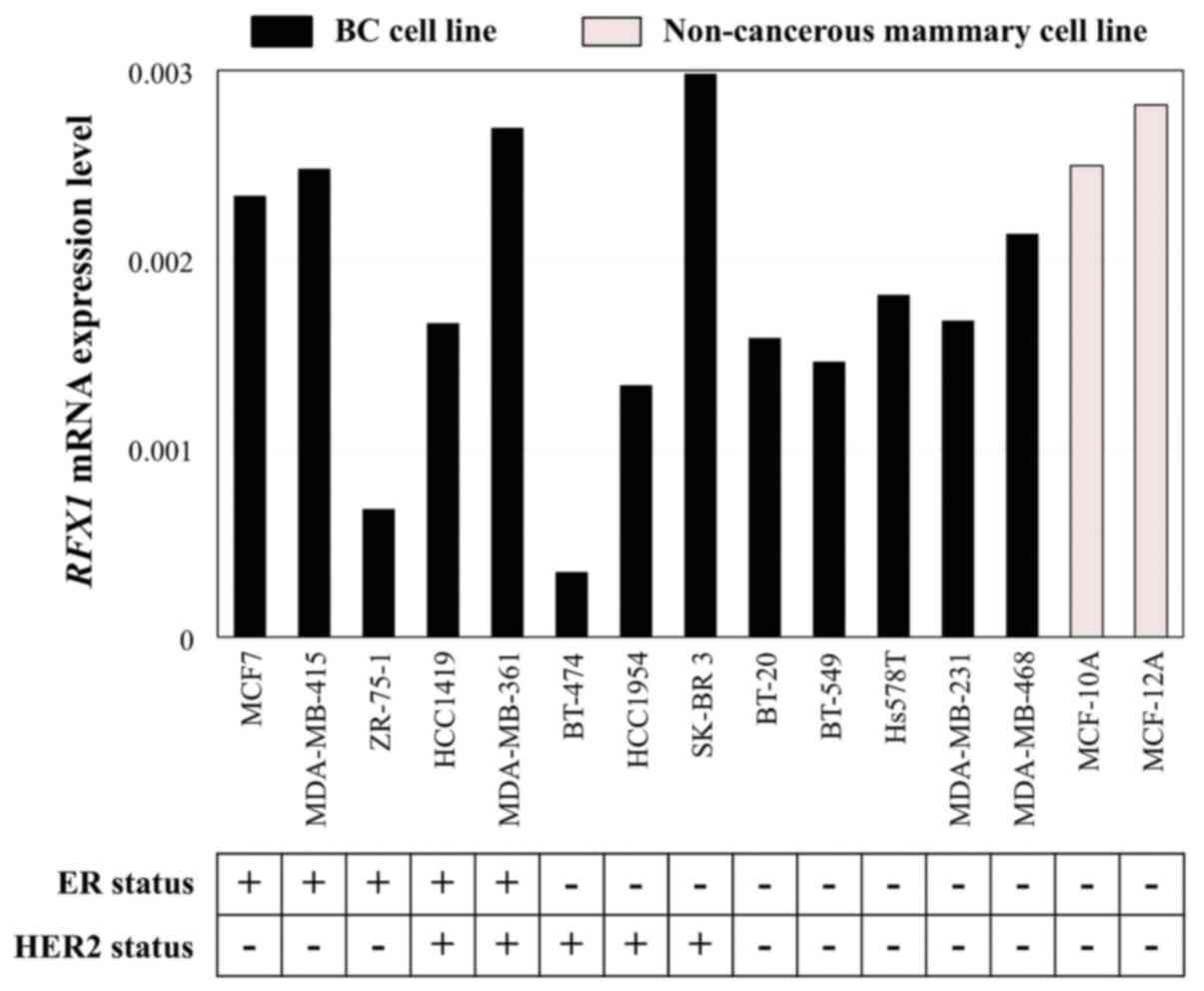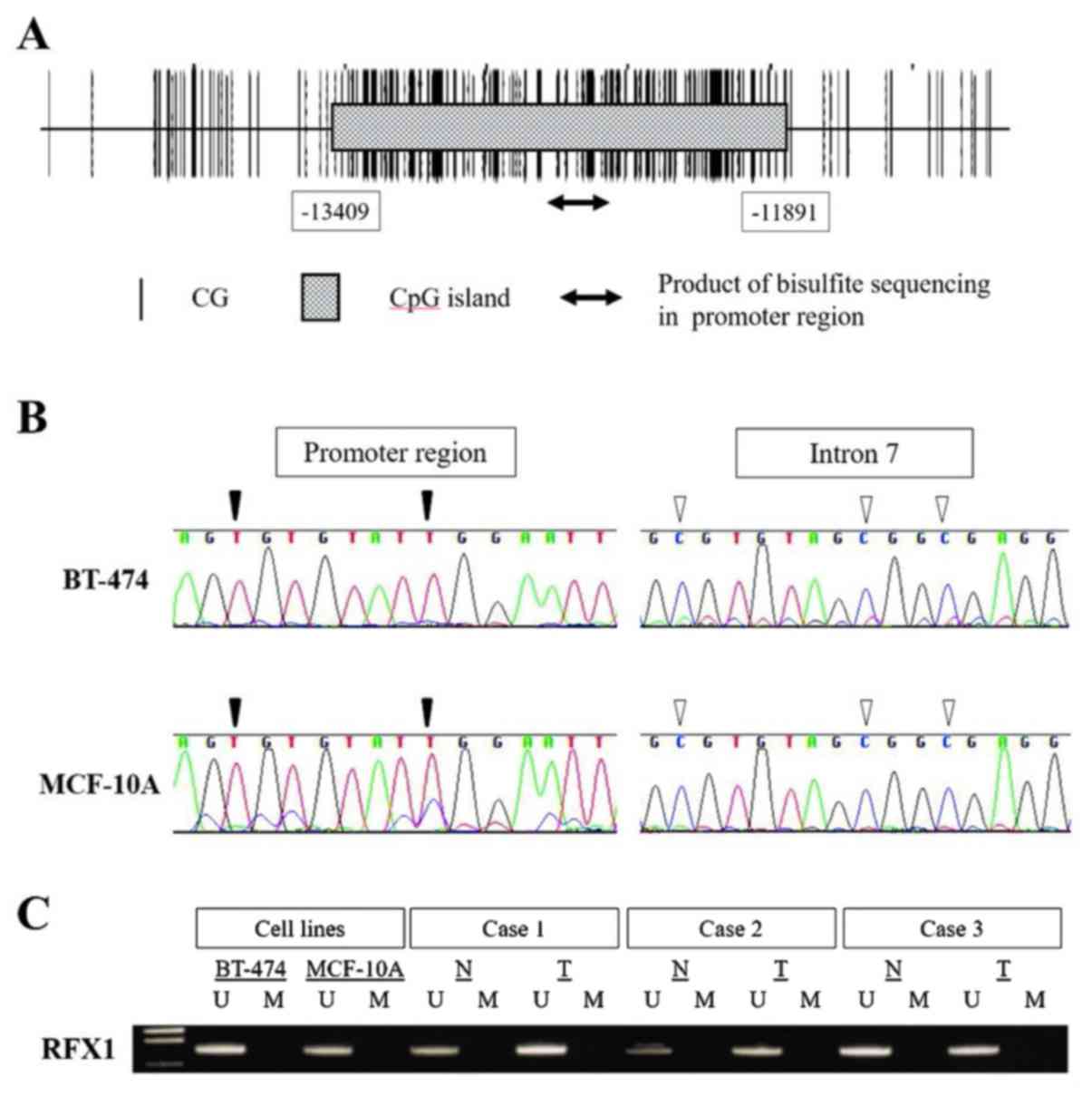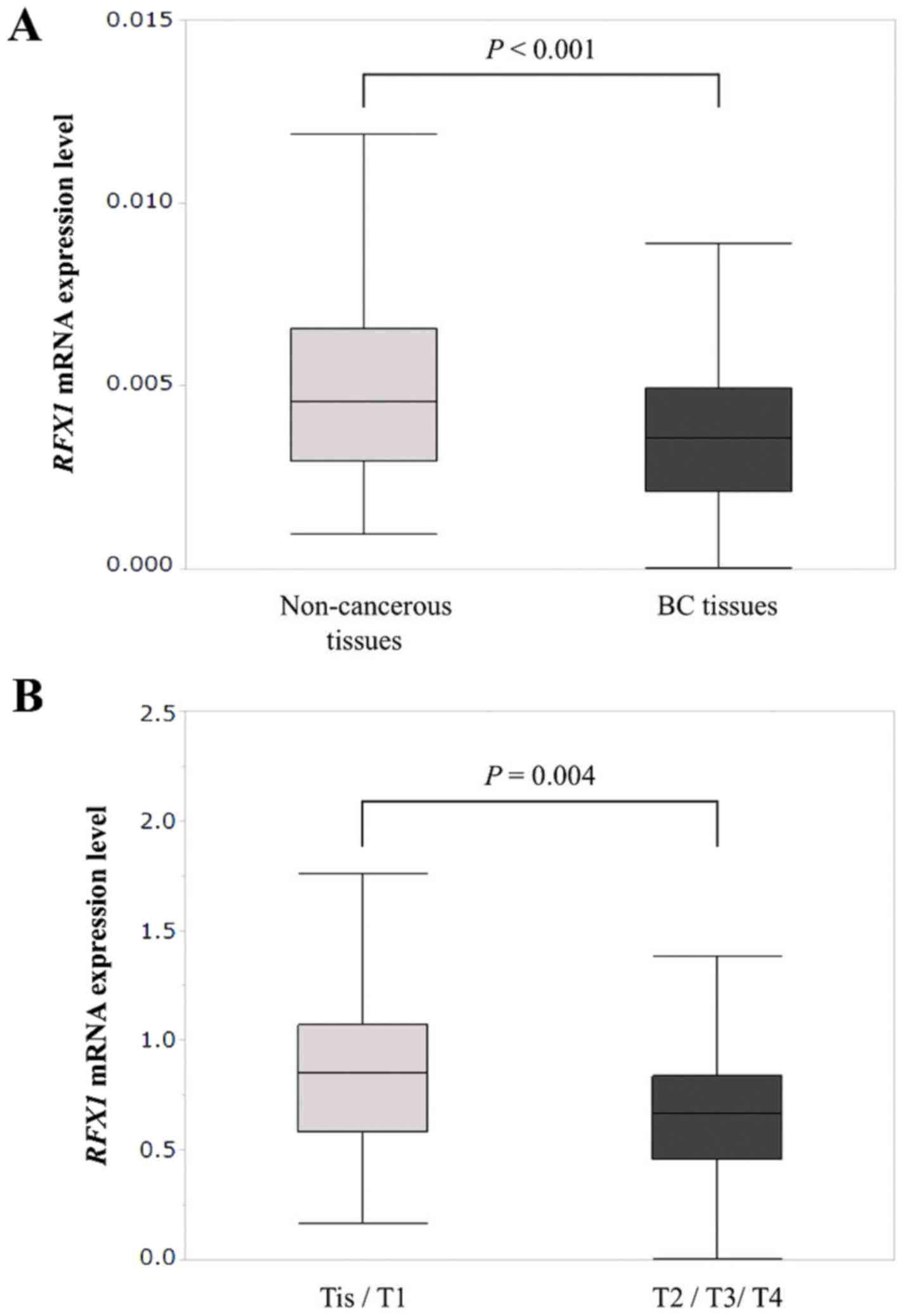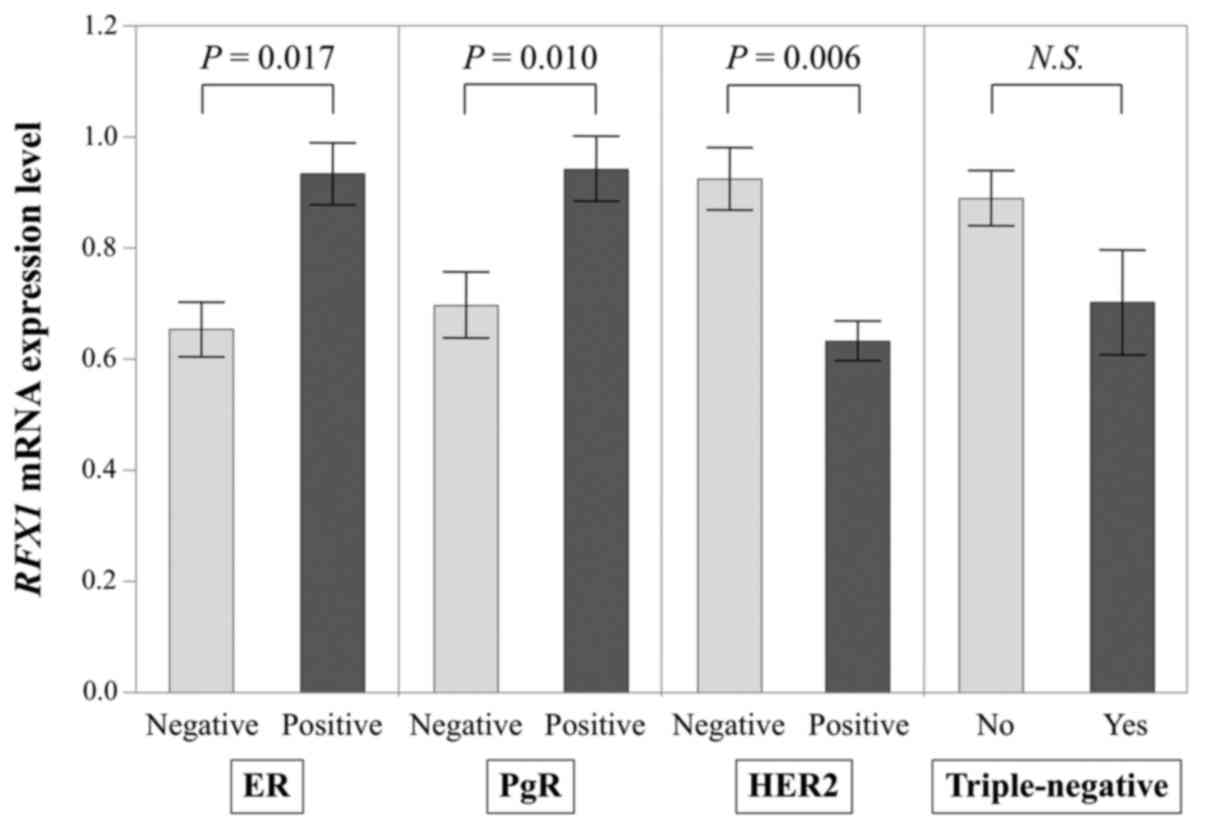Expression of regulatory factor X1 can predict the prognosis of breast cancer
- Authors:
- Published online on: April 7, 2017 https://doi.org/10.3892/ol.2017.6005
- Pages: 4334-4340
Abstract
Introduction
Breast cancer (BC) is the most commonly diagnosed cancer and the leading cause of cancer-related death in women worldwide (1). Approximately 1.7 million new cases of BC and 521,900 deaths related to BC are estimated to have occurred worldwide in 2012 (2). Recurrent BC after resection is frequently intractable and recognized as a major challenge in clinical practice. Currently, adjuvant therapies such as chemotherapy, endocrine therapy and anti-human epidermal growth factor 2 (HER2) agent are administered to BC patients with the aim of prevention of disease recurrences (3). However, many patients have suffered from adverse events and other costs caused by such treatment. Risk stratification is necessary for assessing indication for adjuvant therapy; development of biomarkers for this purpose is therefore needed.
Several commercial multigene expression assays (Oncotype Dx®, MammaPrint®, PAM-50 ROR score®, EndoPredict® and Breast Cancer Index®) are currently available to predict patients' prognoses and to evaluate whether adjuvant chemotherapy is appropriate (3). However, such assays are limited to estrogen receptor (ER)-positive, HER2-negative BC. It's still difficult to predict prognosis of all BC subtypes.
The regulatory factor X1 (RFX1) gene is a member of the regulatory factor X gene family which codes transcription factors (4). Expression and regulatory mechanisms of RFX1 transcription have been reported in connection with several malignancies, including brain tumors (5,6) and hepatocellular carcinoma (7). RFX1 is considered to work as a tumor suppressor by downregulating the proto-oncogene c-myc (8). However, the relationship between RFX1 mRNA expression and patients' clinicopathological factors in BC has not been studied. Here, we focused on RFX1 and investigated its expression in BC cell lines and patients' tumor samples to determine whether it could be a prognostic marker for BC.
Materials and methods
Sample collection
We obtained 13 BC cell lines (BT-20, BT-474, BT-549, HCC1419, HCC1954, Hs578T, MCF7, MDA-MB-231, MDA-MB-361, MDA-MB-415, MDA-MB-468, SK-BR-3 and ZR-75-1) and two non-cancerous mammary gland epithelial cell lines (MCF-10A and MCF-12A). BT-549, HCC1419, HCC1954 and Hs578T were purchased from Japanese Collection of Research Bioresources Cell Bank (Osaka, Japan), BT-474, MCF-7 and MCF-12A were provided to our research team by Johns Hopkins University and Dr. David Sidransky, the director of the Department of Otolaryngology-Head and Neck Surgery of Johns Hopkins University (Baltimore, MD, USA), and others were from the American Type Culture Collection (Manassas, VA, USA). Cells were stored at −80°C using cell preservative solution (Cell Banker; Mitsubishi Chemical Medience Corporation, Tokyo, Japan) and cultured in RPMI-1640 (Sigma-Aldrich, St. Louis, MO, USA) supplemented with 10% fetal bovine serum and in an atmosphere containing 5% CO2 at 37°C (9,10). We acquired 167 primary BC tissues from patients who underwent breast surgery at Nagoya University Hospital between March 2002 and November 2009. All tissue samples were diagnosed histologically as BC, frozen immediately after resection, and stored at −80°C. Adjacent non-cancerous specimens were resected >3 cm away from the edge of the tumor. BC specimens were classified histologically using the 7th edition of the Union for International Cancer Control (UICC) staging system for BC. Adjuvant chemotherapy, endocrine therapy and anti-HER2 therapy were administered to selected patients according to the patient's condition, pathological factors, subtype and the physician's discretion.
This study conforms to the ethical guidelines of the World Medical Association Declaration of Helsinki: Ethical Principles for Medical Research Involving Human Subjects. Written informed consent for use of clinical samples and data was required by the Institutional Review Board at Nagoya University (Nagoya, Japan) and was obtained from all patients.
Reverse transcription-quantitative polymerase chain reaction (RT-qPCR)
Levels of RFX1 mRNA were determined using RT-qPCR. We extracted RNA from cell lines (8.0×106 cells per each cell line), 167 primary BCs, and adjacent normal tissues using the RNeasy Mini kit (Qiagen, Hilden, Germany) according to the manufacture's protocol. cDNA was synthesized from total RNAs (1 µg) by M-MLV Reverse Transcriptase (Invitrogen Life Technologies, Frederick, MD, USA) and Primer ‘random’ (Sigma-Aldrich). Glyceraldehyde-3-phosphate dehydrogenase (GAPDH) mRNA levels were quantified to normalize expression levels. RT-qPCR was performed using the SYBR-Green PCR Core Reagents kit (Applied Biosystems; Thermo Fisher Scientific, Inc., Waltham, MA, USA) as follows: 1 cycle at 95°C for 10 min, 40 cycles at 95°C for 5 sec, and 60°C for 60 sec. All samples were tested in triplicate, and samples without templates were included in each PCR plate as negative controls. Real-time detection of SYBR Green fluorescence was conducted using an ABI StepOnePlus Real-Time PCR System (Applied Biosystems; Thermo Fisher Scientific, Inc.). The expression level of each sample was taken as the value of the RFX1 amplicon divided by that of GAPDH (11,12). Primers specific for RFX1 and GAPDH are listed in Table I.
Surveillance of CpG island around the RFX1 gene
Nucleotide sequence analysis was conducted to determine the presence of CpG island around the promoter region of RFX1. CpG island was defined using the following criteria: At least 500-bp region of DNA with a high GC content (>50%) and an observed CpG/expected CpG ratio of ≥0.6 (13). We used the MethPrime (http://www.urogene.org/methprimer/) to determine the location of CpG island (14).
Bisulfite sequence analysis
Genomic DNA samples from 15 cell lines were subjected to bisulfite treatment using the BisulFlash DNA Modification Kit (EPIGENTEK, Farmingdale, NY, USA); PCR was conducted to detect hypermethylation of the RFX1 promoter region and intron 7 (5), using specific primers (Table I). The PCR amplification protocols were, for the promoter region: 50 cycles at 94°C for 20 sec, 56°C for 20 sec, and 72°C for 25 sec; and for intron 7: 50 cycles at 94°C for 20 sec, 60°C for 20 sec, and 72°C for 25 sec; both amplifications used an initial denaturation step at 94°C for 2 min. PCR products were purified directly using the MinElute PCR Purification Kit (Qiagen). Sequence analysis was carried out by Eurofins Genomics Co. (Tokyo, Japan) (15).
Methylation-specific polymerase chain reaction (MSP)
DNA samples from BC cell lines, clinical BC specimens, and corresponding non-cancerous specimens were subjected to bisulfite treatment. MSP was conducted using specific primers to evaluate the presence of hypermethylation of RFX1 promoter region (Table I). The PCR amplification protocols for MSP and un-MSP (U-MSP) were as follows: 50 cycles at 94°C for 15 sec, 56°C for 15 sec, and 72°C for 30 sec; both amplifications used an initial denaturation step at 94°C for 2 min. Each PCR product was loaded directly on to 2% agarose gels, stained with ethidium bromide and visualized under UV illumination.
Statistical analysis
Differences in levels of RFX1 mRNA between BC and adjacent normal tissues were analyzed using the Mann-Whitney U test. The χ2 test was used to analyze the significance of the association between RFX1 expression and clinicopathological parameters. Overall survival (OS) and disease-free survival (DFS) rates were calculated using the Kaplan-Meier method; difference in survival curves was analyzed using the log-rank test. We performed multivariate regression analyses using the Cox proportional hazards model to identify prognostic factors, and variables for which P<0.05 were entered into the final model. Statistical analyses were performed using JMP 11 software (SAS Institute, Inc., Cary, NC, USA). P<0.05 was considered to indicate a statistically significant difference.
Results
RFX1 mRNA expression and DNA methylation status of BC cell lines
RFX1 mRNA expression levels were heterogeneous among the 13 BC cell lines and two non-cancerous mammary cell lines (Fig. 1). We accepted the reports of each cell line's immunostaining status from previous studies (16,17).
A CpG island was found at upstream of the transcription initiation site of RFX1 (length 1,519 bases; Fig. 2A). We examined the methylation status of the 15 cell lines using bisulfite sequence analysis, which detected no CpG methylation in the RFX1 promoter regions of all cell lines, whereas CpG hypermethylation in intron 7 was detected in all cell lines including the non-cancerous mammary cell lines (Fig. 2B). BT-474, MCF-10A, and three representative clinical BC and corresponding non-cancerous tissues were subjected to MSP. We found absence of methylation in the promoter region of RFX1 gene both in cell lines and clinical samples (Fig. 2C).
Patient characteristics
All 167 patients were women. Their mean age was 54.4±11.6 years (mean ± standard deviation; range, 26–78 years). Their disease stage (by UICC staging system) were stage 0, 7; stage I, 47; stage II, 78; stage III, 34; and stage IV, 1. The median duration of patient follow-up was 100.0 months (range, 8–155 months) or until death. The immunostaining status of primary tumors were ER positive, n=127; negative, n=40; progesterone receptor (PgR) positive, n=115; negative, n=52; and HER2 positive, n=39; negative, n=119.
Mean expression levels of RFX1 mRNA in BC tissues was significantly lower than those in corresponding non-cancerous tissues (P<0.001; Fig. 3A). In 43 (26%) of the 167 patients, RFX1 mRNA expression levels in BC tissues were higher than in adjacent normal tissues. We calculated the ratio of RFX1 mRNA expression levels between BC and adjacent non-cancerous tissues. Patients whose RFX1 mRNA levels were lower in BC tissue than in adjacent tissues were designated as ‘the low RFX1 group’ (n=124), and patients with higher RFX1 expression were designated as ‘the high RFX1 group’ (n=43) in the following analyses.
Clinical significance of RFX1 mRNA levels
The high RFX1 group was significantly associated with less advanced UICC T factor (P=0.028) and lower pathological stage (P=0.015). The high RFX1 group correlated significantly with ER positive (P=0.005), PgR positive (P=0.011), HER2 negative status (P=0.001; Table II).
Table II.Associations between expression of RFX1 mRNA and clinicopathological parameters in 167 patients with breast cancer. |
Mean RFX1 mRNA expression in T2/T3/T4 specimens (n=90) was significantly lower than in the Tis (carcinoma in situ)/T1 group specimens (n=77; P=0.004; Fig. 3B). RFX1 mRNA levels did not significantly differ between patients with negative and positive lymph node metastases (n=85 and 82 respectively, P=0.181), or between UICC stage 0/I/II specimens (n=131) and stage III/IV (n=36; P=0.069).
With regard to relevance to the conventional biomarkers (Fig. 4), RFX1 mRNA levels in ER positive specimens (n=127) were expressed significantly higher than in ER negative specimens (n=40; P=0.017); PgR positive specimens' RFX1 mRNA level (n=115) was also significantly higher than that of PgR negative specimens (n=52; P=0.010); HER2 negative specimens (n=119) expressed significantly more RFX1 mRNA than HER2 positive specimens (n=39; P=0.006; missing HER2 data for 1 patient). RFX1 mRNA levels did not significantly differ between triple-negative (n=18) and other BC subtypes (n=148; P=0.363; missing data for 1 patient).
Prognostic impact of RFX1 mRNA expression
The high RFX1 group experienced significantly longer DFS than the low RFX1 group (5-year DFS rates, high RFX1 group: 95%; low RFX1 group: 77%; P=0.007; Fig. 5A). Among 43 patients of the high RFX1 group, only two suffered recurrences. The OS in the high RFX1 group was also significantly longer than in the low RFX1 group (5-year OS rates, high RFX1 group: 98%; low RFX1 group: 90%; P=0.013; Fig. 5B). Multivariate analysis of DFS identified UICC pathological stage III/IV [hazard ratio (HR): 4.80; 95% confidence interval (CI): 1.80–14.9, P=0.001] and the low RFX1 group (HR, 4.77; 95% CI: 1.32–30.9, P=0.014) as independent prognostic factors (Table III).
Discussion
Our data showed that higher RFX1 expression was associated with less advanced T factor and lower disease stage, and patients with higher RFX1 expression had excellent prognoses.
The RFX1 gene is cytogenetically located at 19p13.1, and belongs to the RFX family genes which share the conserved DNA-binding domain named ‘winged helix’ (4,18). The RFX family codes transcription factors that contain a highly conserved 76-amino acid DNA binding domain (4). RFX1 forms a homodimer or heterodimers with the RFX2 or RFX3 proteins through a dimerization domain (19,20). RFX1-4 can bind methylated DNA sequences preferentially within a sequence-specific, 14-bp consensus sequence (21). As RFX1 downregulates the proto-oncogene c-myc (8), it is considered to be a tumor suppressor. In hepatocellular carcinoma (HCC), RFX1 regulates SC-2001-mediated SHP1 transcription in HCC cell lines, and SC-2001 inhibits tumor growth (7). RFX1 downregulation in tumors has been also verified in glioma (5), neuroblastoma (6), and esophageal adenocarcinoma (22).
We investigated the mRNA expression level and methylation status of RFX1 using BC cell lines and non-cancerous mammary gland epithelial cell lines. The RFX1 mRNA expression levels were heterogeneous across cell lines. There were no reports on hypermethylation of the promoter region of RFX1 gene in non-neoplastic tissues (5). In this study, we found no CpG methylation within the promoter region in cell lines and some clinical tissues. Reportedly, CpGs in intron 7 were hypermethylated in glioma cell lines and tissue samples, although CpG methylation in the promoter region was not seen (5). BC cells were also reported to have hypermethylated CpGs in intron 7 (23). CpGs in gene bodies are sometimes methylated in a tissue-specific manner. Gene body methylation has been shown to increase gene expression contrary to methylation in the promoter region (24). In the current study, we found CpG hypermethylation in intron 7 of all BC cell lines and the non-cancerous mammary cell lines. These results suggest that methylation status is not associated with downregulation of RFX1 mRNA in BC cells.
This study demonstrated that RFX1 mRNA expression has a significant relationship with patients' clinicopathological factors and prognosis. The most striking finding was that the high RFX1 group experienced excellent prognosis (5-year DFS rates, high RFX1 group: 95%; low RFX1 group: 77%). Notably, only two of 43 patients suffered recurrences in the high RFX1 group. Multivariate analysis of DFS identified UICC pathological stage and the low RFX1 group as independent prognostic factors. These results emphasize the usefulness of RFX1 as a prognostic marker. RFX1 mRNA level was indicated as a potent prognostic factor which was independent of ER, PgR or HER2 status. Considering these findings, if a patient's BC specimen's RFX1 mRNA expression is high, adjuvant chemotherapy could be tailored, thus reducing the adverse events and expense associated with chemotherapy.
Breast cancers are commonly treated according to their subtypes (3), which are determined by investigating their immunostaining status for ER, PgR and HER2. The subtype reflects each tumor's character, prognosis and sensitivity to medication. In this study, the high RFX1 group correlated significantly with ER positive, PgR positive and HER2 negative. This result corresponds to our understanding that BC with such phenotypes are less aggressive. Although triple-negative BC is thought to be a more malignant phenotype with a poorer prognosis, our results showed no significant differences between triple-negative BC and other types. This might be because of the small sample size of the triple-negative group.
This is the first study to show the relationship between RFX1 mRNA expression and BC prognosis; and our findings may have several possible clinical applications. For example, RFX1 levels in resected samples might help evaluate each patient's prognosis and need for adjuvant chemotherapy. Multigene expression assays might be refined by adding RFX1 expression. In addition, RFX1 expression can be analyzed by needle biopsy samples before operation, thus aiding in treatment decisions for neoadjuvant therapy.
This study has some limitations. First, the function of RFX1 in BC cells is unknown. Basic functional analyses in which RFX1 expression is inhibited are needed. Second, the mechanism of RFX1 downregulation is still unclear. The methylation status of two regions (the promoter and intron 7) in the RFX1 gene was determined in the present study. Therefore, it remains formally possible that additional intragenic or intergenic regions may have undergone methylation in breast cancer tissues. Mechanisms other than methylation (such as histone modification and micro RNAs) should also be investigated for this gene and its product. Further, this study was conducted retrospectively. Therefore, therapeutic intervention might affect significance of RFX1 mRNA level. Thus study for larger series of patients or prospective study is warranted.
In conclusion, our data indicate that higher expression of RFX1 mRNA level in BC tissue than adjacent normal site predicts better prognosis. RFX1 could become a useful prognostic marker for BC.
References
|
Jemal A, Center MM, DeSantis C and Ward EM: Global patterns of cancer incidence and mortality rates and trends. Cancer Epidemiol Biomarkers Prev. 19:1893–1907. 2010. View Article : Google Scholar : PubMed/NCBI | |
|
Torre LA, Bray F, Siegel RL, Ferlay J, Lortet-Tieulent J and Jemal A: Global cancer statistics, 2012. CA Cancer J Clin. 65:87–108. 2015. View Article : Google Scholar : PubMed/NCBI | |
|
Coates AS, Winer EP, Goldhirsch A, Gelber RD, Gnant M, Piccart-Gebhart M, Thürlimann B and Senn HJ: Panel Members: Tailoring therapies-improving the management of early breast cancer: St Gallen international expert consensus on the primary therapy of early breast cancer 2015. Ann Oncol. 26:1533–1546. 2015. View Article : Google Scholar : PubMed/NCBI | |
|
Emery P, Durand B, Mach B and Reith W: RFX proteins, a novel family of DNA binding proteins conserved in the eukaryotic kingdom. Nucleic Acids Res. 24:803–807. 1996. View Article : Google Scholar : PubMed/NCBI | |
|
Ohashi Y, Ueda M, Kawase T, Kawakami Y and Toda M: Identification of an epigenetically silenced gene, RFX1, in human glioma cells using restriction landmark genomic scanning. Oncogene. 23:7772–7779. 2004. View Article : Google Scholar : PubMed/NCBI | |
|
Feng C, Zhang Y, Yin J, Li J, Abounader R and Zuo Z: Regulatory factor X1 is a new tumor suppressive transcription factor that acts via direct downregulation of CD44 in glioblastoma. Neuro Oncol. 16:1078–1085. 2014. View Article : Google Scholar : PubMed/NCBI | |
|
Su JC, Tseng PH, Hsu CY, Tai WT, Huang JW, Ko CH, Lin MW, Liu CY, Chen KF and Shiau CW: RFX1-dependent activation of SHP-1 induces autophagy by a novel obatoclax derivative in hepatocellular carcinoma cells. Oncotarget. 5:4909–4919. 2014. View Article : Google Scholar : PubMed/NCBI | |
|
Chen L, Smith L, Johnson MR, Wang K, Diasio RB and Smith JB: Activation of protein kinase C induces nuclear translocation of RFX1 and down-regulates c-myc via an intron 1 X box in undifferentiated leukemia HL-60 cells. J Biol Chem. 275:32227–32233. 2000. View Article : Google Scholar : PubMed/NCBI | |
|
Kanda M, Shimizu D, Fujii T, Tanaka H, Shibata M, Iwata N, Hayashi M, Kobayashi D, Tanaka C, Yamada S, et al: Protein arginine methyltransferase 5 is associated with malignant phenotype and peritoneal metastasis in gastric cancer. Int J Oncol. 49:1195–1202. 2016.PubMed/NCBI | |
|
Kanda M, Shimizu D, Nomoto S, Takami H, Hibino S, Oya H, Hashimoto R, Suenaga M, Inokawa Y, Kobayashi D, et al: Prognostic impact of expression and methylation status of DENN/MADD domain-containing protein 2D in gastric cancer. Gastric Cancer. 18:288–296. 2015. View Article : Google Scholar : PubMed/NCBI | |
|
Kanda M, Nomoto S, Oya H, Takami H, Shimizu D, Hibino S, Hashimoto R, Kobayashi D, Tanaka C, Yamada S, et al: The expression of melanoma-associated antigen D2 both in surgically resected and serum samples serves as clinically relevant biomarker of gastric cancer progression. Ann Surg Oncol. 23:(Suppl 2). S214–S221. 2016. View Article : Google Scholar : PubMed/NCBI | |
|
Kanda M, Shimizu D, Fujii T, Sueoka S, Tanaka Y, Ezaka K, Takami H, Tanaka H, Hashimoto R, Iwata N, et al: Function and diagnostic value of Anosmin-1 in gastric cancer progression. Int J Cancer. 138:721–730. 2016. View Article : Google Scholar : PubMed/NCBI | |
|
Takai D and Jones PA: Comprehensive analysis of CpG islands in human chromosomes 21 and 22. Proc Natl Acad Sci USA. 99:3740–3745. 2002. View Article : Google Scholar : PubMed/NCBI | |
|
Li LC and Dahiya R: MethPrimer: Designing primers for methylation PCRs. Bioinformatics. 18:1427–1431. 2002. View Article : Google Scholar : PubMed/NCBI | |
|
Kanda M, Shimizu D, Tanaka H, Shibata M, Iwata N, Hayashi M, Kobayashi D, Tanaka C, Yamada S, Fujii T, et al: Metastatic pathway-specific transcriptome analysis identifies MFSD4 as a putative tumor suppressor and biomarker for hepatic metastasis in patients with gastric cancer. Oncotarget. 7:13667–13679. 2016.PubMed/NCBI | |
|
Finn RS, Dering J, Conklin D, Kalous O, Cohen DJ, Desai AJ, Ginther C, Atefi M, Chen I, Fowst C, et al: PD 0332991, a selective cyclin D kinase 4/6 inhibitor, preferentially inhibits proliferation of luminal estrogen receptor-positive human breast cancer cell lines in vitro. Breast Cancer Res. 11:R772009. View Article : Google Scholar : PubMed/NCBI | |
|
Subik K, Lee JF, Baxter L, Strzepek T, Costello D, Crowley P, Xing L, Hung MC, Bonfiglio T, Hicks DG and Tang P: The expression patterns of ER, PR, HER2, CK5/6, EGFR, Ki-67 and AR by immunohistochemical analysis in breast cancer cell lines. Breast Cancer (Auckl). 4:35–41. 2010.PubMed/NCBI | |
|
Gajiwala KS, Chen H, Cornille F, Roques BP, Reith W, Mach B and Burley SK: Structure of the winged-helix protein hRFX1 reveals a new mode of DNA binding. Nature. 403:916–921. 2000. View Article : Google Scholar : PubMed/NCBI | |
|
Reith W, Ucla C, Barras E, Gaud A, Durand B, Herrero-Sanchez C, Kobr M and Mach B: Rfx1, A transactivator of hepatitis-B virus enhancer-I, belongs to a novel family of homodimeric and heterodimeric DNA-binding proteins. Mol Cell Biol. 14:1230–1244. 1994. View Article : Google Scholar : PubMed/NCBI | |
|
Katan-Khaykovich Y, Spiegel I and Shaul Y: The dimerization/repression domain of RFX1 is related to a conserved region of its yeast homologues Crt1 and Sak1: A new function for an ancient motif. J Mol Biol. 294:121–137. 1999. View Article : Google Scholar : PubMed/NCBI | |
|
Sengupta PK, Smith EM, Kim K, Murnane MJ and Smith BD: DNA hypermethylation near the transcription start site of collagen alpha2(I) gene occurs in both cancer cell lines and primary colorectal cancers. Cancer Res. 63:1789–1797. 2003.PubMed/NCBI | |
|
Watts JA, Zhang C, Klein-Szanto AJ, Kormish JD, Fu J, Zhang MQ and Zaret KS: Study of FoxA pioneer factor at silent genes reveals Rfx-repressed enhancer at Cdx2 and a potential indicator of esophageal adenocarcinoma development. PLoS Genet. 7:e10022772011. View Article : Google Scholar : PubMed/NCBI | |
|
Rauscher GH, Kresovich JK, Poulin M, Yan L, Macias V, Mahmoud AM, Al-Alem U, Kajdacsy-Balla A, Wiley EL, Tonetti D and Ehrlich M: Exploring DNA methylation changes in promoter, intragenic, and intergenic regions as early and late events in breast cancer formation. BMC Cancer. 15:8162015. View Article : Google Scholar : PubMed/NCBI | |
|
Yang X, Han H, De Carvalho DD, Lay FD, Jones PA and Liang G: Gene body methylation can alter gene expression and is a therapeutic target in cancer. Cancer Cell. 26:577–590. 2014. View Article : Google Scholar : PubMed/NCBI |














